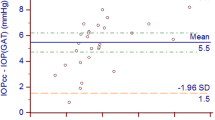Abstract
Purpose
To evaluate corneal biomechanical changes after Descemet stripping automated endothelial keratoplasty (DSAEK), penetrating keratoplasty (PK), and phacoemulsification (PE).
Methods
This prospective study included 138 eyes which underwent PK (26 eyes), DSAEK (26 eyes), PE (57 eyes), and 29 normal eyes. Intraocular pressure (IOP) was measured by Goldmann applanation tonometer (GAT), and central corneal thickness (CCT) and axial length by ultrasound. The ocular response analyzer was used to measure corneal hysteresis (CH), corneal resistance factor (CRF), Goldmann-related IOP (IOPg), and cornea-compensated IOP (IOPcc) preoperatively and 1, 3, and 6 months postoperatively.
Results
At baseline, PK group had the lowest CH and CRF. There was a significant increase in CH and CRF to normal values in PK (P = 0.015 and 0.006) and PE (P = 0.005 and 0.0001) groups over the study period. At 6 months, CH and CRF increased and reached normal values in the PK group; increased to a lower level than normal in the DSAEK group; and, after an initial reduction, increased to normal values in the PE group. At 6 months, DSAEK group had the lowest CH and CRF. There was a significant positive correlation between CRF and GAT (r = 0.281, P = 0.009), IOPg and GAT (r = 0.335, P = 0.001), and IOPcc and GAT (r = 0.282, P = 0.001). CH was negatively correlated with age (r = − 0.189, P = 0.04).
Conclusion
Corneal biomechanical factors increase after DSAEK and PK. At post-operative month six, they reach normal values in PK group, but are lower than normal in DSAEK group.


Similar content being viewed by others
References
Luce DA (2005) Determining in vivo biomechanical properties of the cornea with an ocular response analyzer. J Cataract Refract Surg 31(1):156–162
Kotecha A, Elsheikh A, Roberts CR, Zhu H, Garway-Heath DF (2006) Corneal thickness-and age-related biomechanical properties of the cornea measured with the ocular response analyzer. Invest ophthalmol Vis Sci 47(12):5337–5347
Touboul D, Roberts C, Kérautret J, Garra C, Maurice-Tison S, Saubusse E et al (2008) Correlations between corneal hysteresis, intraocular pressure, and corneal central pachymetry. J Cataract Refract Surg 34(4):616–622
Ramm L, Herber R, Spoerl E, Pillunat LE, Terai N (2019) Measurement of corneal biomechanical properties in diabetes mellitus using the Ocular Response Analyzer and the Corvis ST. Cornea 38(5):595–599
Feizi S, Montahai T, Moein H (2015) Graft biomechanics following three corneal transplantation techniques. J Ophthalmic Vis Res 10(3):238–242
Kucumen RB, Yenerel NM, Gorgun E, Kulacoglu DN, Oncel B, Kohen MC et al (2008) Corneal biomechanical properties and intraocular pressure changes after phacoemulsification and intraocular lens implantation. J Cataract Refract Surg 34(12):2096–2098
Hager A, Loge K, Füllhas M-O, Schroeder B, Großherr M, Wiegand W (2007) Changes in corneal hysteresis after clear corneal cataract surgery. Am J Ophthalmol 144(3):341–346
Murugesan V, Bypareddy R, Kumar M, Tanuj D, Anita P (2014) Evaluation of corneal biomechanical properties following penetrating keratoplasty using ocular response analyzer. Indian J Ophthalmol 62(4):454–460
Shin JY, Choi JS, Oh JY, Kim MK, Lee JH, Wee WR (2010) Evaluation of corneal biomechanical properties following penetrating keratoplasty using the ocular response analyzer. Korean J Ophthalmol 24(3):139–142
Ziaei M, Vellara HR, Gokul A, Ali NQ, McGhee CN, Patel DV (2020) Comparison of corneal biomechanical properties following penetrating keratoplasty and deep anterior lamellar keratoplasty for keratoconus. Clin Exp Ophthalmol 48(2):174–182
Faramarzi A, Feizi S, Najdi D, Ghiasian L, Karimian F (2016) Changes in corneal biomechanical properties after Descemet stripping automated endothelial keratoplasty for pseudophakic bullous keratopathy. Cornea 35(1):20–24
Feizi S, Einollahi B, Yazdani S, Hashemloo A (2012) Graft biomechanical properties after penetrating keratoplasty in keratoconus. Cornea 31(8):855–858
Yenerel NM, Kucumen RB, Gorgun E (2010) Changes in corneal biomechanics in patients with keratoconus after penetrating keratoplasty. Cornea 29(11):1247–1251
Hosny M, Hassaballa MAM, Shalaby A (2011) Changes in corneal biomechanics following different keratoplasty techniques. Clin Ophthalmol 5:767–770
Abdelkader A (2013) Influence of different keratoplasty techniques on the biomechanical properties of the cornea. Acta Ophthalmol 91(7):e567-572
Abd Elaziz MS, Elsobky HM, Zaky AG, Hassan EAM, KhalafAllah MT (2019) Corneal biomechanics and intraocular pressure assessment after penetrating keratoplasty for non keratoconic patients, long term results. BMC Ophthalmol 19(1):172
Laiquzzaman M, Tambe K, Shah S (2010) Comparison of biomechanical parameters in penetrating keratoplasty and normal eyes using the Ocular Response Anaslyser. Clin Exp Ophthalmol 38:758–763
Jiang MS, Zhu JY, Li X, Zhang NN, Zhang XD (2017) Corneal biomechanical properties after penetrating keratoplasty or deep anterior lamellar keratoplasty using the ocular response analyzer: a meta-analysis. Cornea 36(3):310–316
Feizi S, Faramarzi A, Masoudi A, Azari AA, Veisi A (2018) Goldmann applanation tonometer versus ocular response analyzer for measuring intraocular pressure after descemet stripping automated endothelial keratoplasty. Cornea 37(11):1370–1375
Song X, Langenbucher A, Gatzioufas Z, Seitz B, El-Husseiny M (2014) Effect of biometric characteristics on the change of biomechanical properties of the human cornea due to cataract surgery. Biomed Res Int 2014:628019
Funding
The authors have not disclosed any funding.
Author information
Authors and Affiliations
Corresponding author
Ethics declarations
Competing interest
There is no conflict of interest for any authors to disclose.
Ethical approval
All procedures performed were in accordance with the ethical standards of the institutional research committee and with the 1964 Helsinki declaration and its later amendments or comparable ethical standards. This article does not contain any studies with animals performed by any of the authors.
Informed consent
Informed consent was obtained from all individual participants included in the study.
Additional information
Publisher's Note
Springer Nature remains neutral with regard to jurisdictional claims in published maps and institutional affiliations.
Rights and permissions
About this article
Cite this article
Rahimi, M., Panahi Bazaz, M., Sharifipour, F. et al. Corneal biomechanical changes after Descemet stripping automated endothelial keratoplasty, penetrating keratoplasty, and phacoemulsification. Int Ophthalmol 42, 3183–3190 (2022). https://doi.org/10.1007/s10792-022-02318-1
Received:
Accepted:
Published:
Issue Date:
DOI: https://doi.org/10.1007/s10792-022-02318-1




